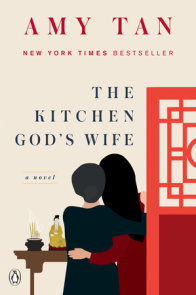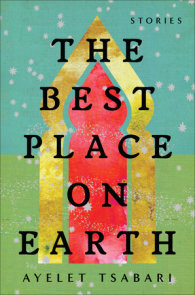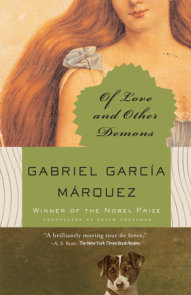READERS GUIDE
NATIONAL BESTSELLER“Joyful, fizzy…. This is one of those novels that blithely leap across the border between literary and popular fiction.” —The New York Times Book Review
Sandra Cisneros, the award-winning author of the highly acclaimed The House on Mango Street and several other esteemed works, has produced a stunning new novel, Caramelo. This long-anticipated novel is an all-embracing epic of family history, Mexican history, the immigrant experience, and a young Mexican-American woman’s road to adulthood. We hope the following introduction, discussion questions, suggested reading list, and author biography enhance your group’s reading of this captivating and masterful literary work.
Introduction
Born the seventh child and only daughter to Zoila and Inocencio Reyes, Celaya Reyes spends her childhood traveling back and forth between her family’s home in Chicago to her father’s birth home in Mexico City, Mexico. Celaya’s intimidating paternal grandmother, adored and revered by Celaya’s father, dominates these visits, and Celaya dubs her the Awful Grandmother. Celaya’s story begins one summer in Mexico when she is just a little girl, but soon her girlhood experiences segue back in time—to before Celaya was born—to her grandparents’ history. Celaya traces the Awful Grandmother’s lonely and unhappy childhood in a Mexico ravaged by the Mexican Revolution of 1911, her meeting and ultimate union with Celaya’s grandfather, Narciso Reyes (the Little Grandfather), and the birth of their first and favorite son, Celaya’s father, Inocencio. Inocencio Reyes moves to the United States as a young man, and soon meets Zoila, a woman with her own colorful mixed-Mexican parentage. Celaya develops the portrait of her parents’ love-based, but volatile marriage and the growth of their own Mexican-American family. After the Little Grandfather’s death, the family moves the Awful Grandmother up to the United States with them, first to Chicago, then to San Antonio. Soon afterward, the Awful Grandmother dies, leaving her teenage granddaughter to struggle with her unresolved relationship with her late grandmother. Through her grandmother’s history, Celaya discovers her own heritage, enabling her ultimately to carve out an identity of her own in the two countries she inhabits and that inhabit her—Mexico and America.As the family’s self-appointed historian, or storyteller, Celaya’s tale weaves Mexican social, political, and military history around intimate family secrets and the stormy and often mysterious relationships among multiple generations of family members. The marvelous, often riotous cast of characters that march through time and across the North American continent ranges from close family members to Mexican-American icons of popular culture that have random encounters with the Reyes family (i.e., Señor Wences with his painted talking hand [pp. 215–221].) The spirited, likeable characters, while at times mythological in their characteristics, are always intensely human in their flaws and emotions. While each character can claim equal footing in the Reyes web of family and history, each holds a role of differing significance in Celaya’s personal odyssey of connecting to her roots and carving her future.
Questions and Topics for Discussion
1. From the novel’s opening epigraph—“Tell me a story, even it it’s a lie”—to its end, the relationship between truth, lies, history, and storytelling is an important theme. Posits Celaya, “Did I dream it or did someone tell me the story? I can’t remember where the truth ends and the talk begins” [p. 20]. And while she is assuring us, “I wish I could tell you about this episode in my family’s history, but nobody talks about it, and I refuse to invent what I don’t know” [p. 134], she also acknowledges, “The same story becomes a different story depending on who is telling it” [p. 156]. For example, clearly the Awful Grandmother is sugarcoating the truth about her marriage to Narciso [p. 171]. What other aspects of the novel are evidently “untruthful”? Is the reader to believe that Caramelo is just a “different kind of lie” [p. 246]?
2. Celaya says, “I’m not ashamed of my past. It’s the story of my life I’m sorry about” [p. 399]. What’s the difference?
3. The narrative transitions from one storyteller’s point of view, or voice, to another’s in different parts of the story. For example, in Chapter 22, Celaya as the storyteller engages in a dialogue with the Awful Grandmother about the way the grandmother’s story is being told [pp. 91–123]. Then, in Chapter 29, Narciso begins to tell his own story of when he lived in Chicago [p. 137]. And later, in Chapters 37–45, the dialogue between Celaya and the Awful Grandmother returns. Celaya seems to find her own voice and point of view in Chapter 59. What does the author achieve by shifting the viewpoint from character to character? How does the tone change to reflect the voices of a poor Mexican orphan, a young officer in the Mexican army, an American teenage girl, and others? How does this narrative device affect the reader’s ability to sympathize or empathize with the characters?
4. Often elements of one person’s life are echoed later in the story, in either the same character’s life or in another character’s. For example, Cisneros uses the same sentence—“And it was good and joyous and blessed”—to describe Grandmother’s first sexual encounter with Narciso [p. 154] and later her death [p. 348]. And the argument between Mother and Celaya [p. 359] echoes the earlier argument between Aunty Light-Skin and the Awful Grandmother [p. 262]. Where are there other examples of this repetition within the novel? What themes does this structural repetition help convey?
5. The family history that forms the central story line of Caramelo is structured in part chronologically and in part by the relationships formed by different family members. As our narrator informs us: “Because a life contains a multitude of stories and not a single strand explains precisely the who of who one is, we have to examine the complicated loops that allowed Regina to become la Señora Reyes” [p. 115]. Does this nonlinear plot structure support the assertion that family and history are without beginning, middle, or end, but are, rather, a “pattern” [p. 399]?
6. How does the historical chronology at the end of the novel edify the Reyes family events that take place within the body of the narrative—and vice versa? In other words, since the reader probably read the story before the chronology, how do the fictional family events illuminate the factual chronology of United States and Mexican history? Is Caramelo like or different from other historical fictions, such as Alex Haley’s Roots, with which the reader might be familiar?
7. The theme expressed in the following statement is reemphasized throughout the novel: “We are all born with our destiny. But sometimes we have to help our destiny a little” [p. 106]. For example, Viva tells Celaya: “I believe in destiny as much as you do, but sometimes you’ve gotta help your destiny along” [p. 345]. What exactly is the nature or power of the “destiny” that the characters seem to revere? Who or what is really in control of the lives and histories portrayed? How is destiny different for Celaya, her grandmother, her parents, and her friend Viva? Celaya says of Ernesto: “He was my destiny, but not my destination” [p. 399]. What is the difference?
8. How does the oft-repeated phrase “just enough, but not too much” [e.g., p. 29] describe the kind of person the Awful Grandmother is? What aspects, if any, of the Awful Grandmother’s life story parallel Celaya’s life story? Are the Awful Grandmother and Celaya alike in character, and if so, in what ways? How does Celaya, who upon her grandmother’s death “can’t think of anything to say for my grandmother who is simply my father’s mother and nothing to me” [p. 350], ultimately come to feel that she’s “turned into her. And [can] see inside her heart” [p. 424]? What does the Awful Grandmother teach Celaya about herself?
9. Celaya writes, “On Sunday mornings other families go to church. We go to Maxwell Street” [p. 294]. Does she relate this cynically or humorously, or both? What religious beliefs does Celaya hold? How is her faith or religion different from Zoila’s, who is portrayed as having no faith at all [Chapter 62], or from the faith or religion of the Awful Grandmother [see, for example, p. 191]?
10. What is the role played in the novel by the various Mexican or Mexican-American figures of popular culture who have encounters with members of the Reyes family? How does Cisneros use these characters to convey both the individuality as well as the universality of the Mexican-American immigrant experience?
11. The characters in Caramelo make frequent observations about Mexicans. For example, Zoila asserts that “all people from Mexico City are liars” [p. 353], and Celaya comments “We’re so Mexican. So much left unsaid” [p. 428]. With what tone do the characters deliver these types of generalizations, and how are they to be interpreted? Why might these characters portray their native countrymen in this way? Do people of other cultures make similarly deprecating comments, and what purpose might making such comments serve for such people?
12. How does the Reyes family view the United States as compared to Mexico? How are the two countries portrayed in Caramelo on both political and social levels? Celaya observes that “[e]veryone in Chicago lived with an idea of being superior to someone else, and they did not, if they could help it, live on the same block without of lot of readjustments, of exceptions made for the people they know by name instead of as ‘those so-and so’s’” [p. 289–290]. Is this different or similar to how people from different classes or ethnicities (such as the Indians) in Mexico City treat or view each other?
13. The Reyes family members move fluidly throughout the book between Mexico and the United States. Does the ease of such movement diminish for each generation? How does the immigration of Inocencio and his siblings and first cousins reflect immigration between the countries in the middle part of the twentieth century, and how has immigration to the United States from Mexico changed today? How do the changes in immigration reflect the changes in the relationship between the countries? How does Caramelo reflect the immigrant experience generally for the middle part of the twentieth century, and how have changes within the United States both socially and politically affected the contemporary immigrant experience?
14. For the Reyes family members who immigrate to the United States, which elements of Mexico are preserved in America and which are lost in the process of assimilation? Is it necessary for an immigrant to lose something of his or her original culture in order to assimilate into a new culture and, once assimilated, are the old ways lost for good? Does being “American” mean something different for the first generation of immigrants such as Inocencio than for the American-born Zoila or their daughter, the American-born Celaya? How does Celaya reconcile her Mexican legacy with her American future, and does this reconciliation give meaning to the term “Mexican-American”? How do shifting external border relations between Mexico and the United States reflect or affect the characters’ internal conflicts between their Mexican and American identities?
15. Aunty Light-Skin proclaims: “Because that’s how los gringos are, they don’t have any morals. They all have dinner with each other’s exes like it was nothing. ‘That’s because we’re civilized,’ a turista once explained to me. What a barbarity! Civilized? You call that civilized? Like dogs. Worse than dogs. If I caught my ex with his ‘other’ I’d stab them both with a kitchen fork. I would!” [p. 273]. What system of morality do the Reyes abide by? Does this code of morality reflect a more Mexican, more American, or a Mexican-American way of thinking? What cultural differences between Mexicans and Americans does Aunty Light-Skin’s proclamation illustrate?
16. “There is nothing Mexican men revere more than their mamas; they are the most devoted of sons perhaps because their mamas are the most devoted of mamas…when it comes to their boys” [p. 128]. What explains the strength of the relationship between Inocencio and the Awful Grandmother? Is the relationship between Zoila and Toto equally strong? Why or why not? How can mothers and daughters, such as Aunty Light-Skin and the Awful Grandmother, or Celaya and Zoila, successfully relate to each other in the face of such strong mother-son relationships? Is the favoritism these mothers show for their sons unique to Mexican culture? How does the bond between a son and his mother compare to the relationship between Celaya and Inocencio?
17. How does the fact of Candelaria’s parentage affect each of the family members differently—Zoila, the grandmother, Celaya? Does the information that Candelaria’s father is Inocencio change relationships between or among any of the Reyes family members?
18. Celaya says, “Life was cruel. And hilarious all at once” [p. 30]. And when things seem to have reached a low point in her life, she proclaims, “Celaya. I’m still myself. Still Celaya. Still alive. Sentenced to my life for however long God feels like laughing” [p. 357]. What attitude does Celaya have toward her own life? What keeps her going?
19. Inocencio tells Celaya: “Always remember, Lala, the family comes first—la familia” [p. 360]. Does her needy call home to Papa after her episode with Ernesto in Mexico City prove her father right [p. 390]? How does Celaya reconcile her father’s statement about family with her own vision of her future as an independent woman?
20. The first time the word “caramelo” appears in the book is when it is used to describe Candelaria’s skin tone [p. 34]. The second time is to name the color of the Awful Grandmother’s uncompleted rebozo [p. 58]. How are the two events connected? Why might Cisneros have chosen Caramelo for the title? What does the caramelo rebozo mean to Celaya the storyteller? To Celaya the Reyes family member? [See pp. 426–430.]
21. Cisneros employs elaborate and vivid food metaphors, such as “Regina was like the papaya slices she sold with lemon and a dash of chile; you could not help but want to take a little taste” [p. 117] and “Have you ever been that sad? Like a donut dunked in coffee” [p. 274]. Is taste the strongest sense her metaphors invoke? How does she also invoke the senses of smell, sight, and sound? What does Cisneros achieve stylistically or thematically by invoking these senses?
22. In Chapter 66 (“Nobody but Us Chickens”) the Grandmother gets sick—then, before Celaya reports to the reader her grandmother’s fate, she relates in Chapter 67 (“The Vogue”) how she and Viva got caught shoplifting. Why might Cisneros have juxtaposed these two chapters? Celaya also sets up family mysteries and delays solving them until much later in the novel. For example, the mystery of why Celaya is missing from the photograph on the beach is answered later. Are there other examples of such mysteries, and how does Cisneros use these mysteries to structure the plot and move it along?
23. Does Celaya betray her father by telling the story? Is Inocencio right that the family portrayed in Caramelo appears “shameless,” as he cautions Celaya [p. 430]? If not, how might one describe the family portrayed in Caramelo?
24. How does Caramelo push the stylistic boundaries of a traditional novel? Does the author’s use of footnotes; different voices; repetition; Spanish language, songs, and poetry; as well as other stylistic devices alter the definitions of form and structure? How do such stylistic devices reinforce the themes of the novel?




















